Rediscovering Drucker's Theory of Innovation
Transforming Japan into an entrepreneurial society
Dr. Richard Straub, Founder and President, Peter Drucker Society Europe Commemorative Japan Seminar
Famed management guru Peter Drucker called for companies to become more entrepreneurial and to develop their human resources. Are Japanese companies up to the task?
Fujitsu held a kickoff event at the Fujitsu Digital Transformation Center in Hamamatsucho, Japan, on Sept. 21, 2017. The event, "Can Japan Become an Entrepreneurial Society According to Peter Drucker? – A Playbook for Japanese Corporate Innovation" – was a precursor to the 11th TOPOS Conference.
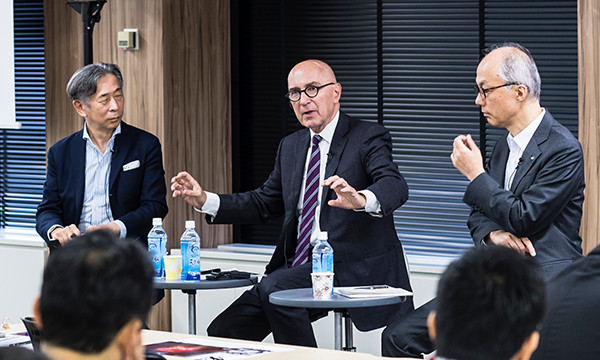
With Professor Noboru Konno of Tama Graduate School of Business as moderator, Dr. Richard Straub, founder and president of the Peter Drucker Society Europe, and Yoshikuni Takashige, Vice President of Marketing Strategy and Vision at Fujitsu, spoke about Drucker's notions of innovation and how they impact entrepreneurial societies. They also participated in a lively panel discussion about challenges facing Japanese companies as they deal with the coming entrepreneurial society.
The Need for Japan to Transform Its Business Environment
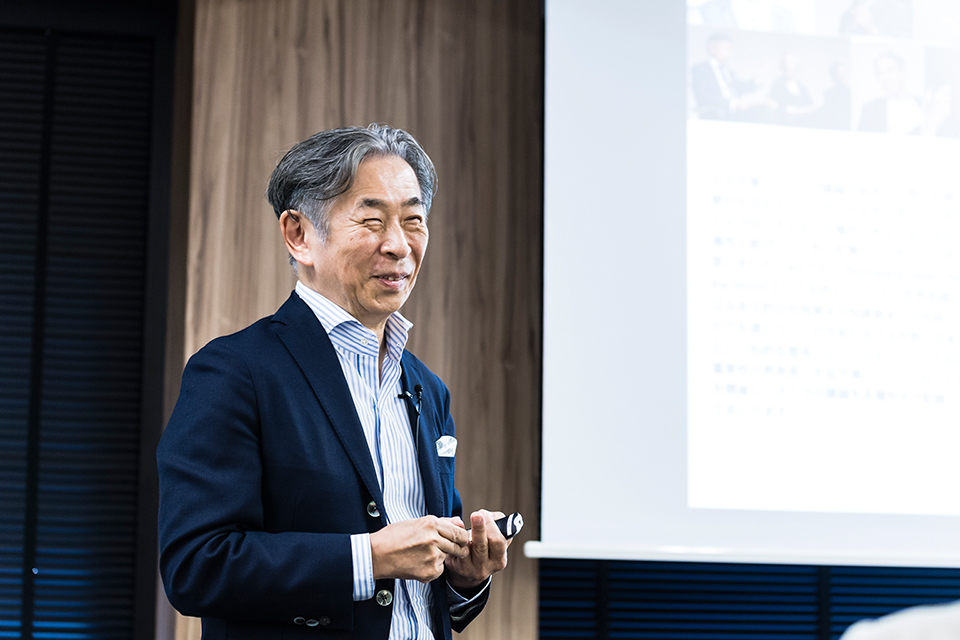
In his opening remarks, Professor Konno noted that the younger generations of Japanese have been turned off by the country's style of corporate management, most of which is outdated and irrelevant in today's dynamic business environment. Now is "the best time for us to revisit Japanese management practices in the context of the new millennium," Konno said.
Drawing on core concepts of Drucker, Konno outlined the event, which would explore how Japan could transform its business environment into one that encourages the entrepreneurial spirit.
Even before the 1970's, at a time when Japanese business practices and innovation had started attracting much interest from US and European managers, Drucker had been aware of the strengths of the country's ways of doing business. However, now it appears that such strengths have been lost, or at best are gradually fading into obsolescence, said Konno.
While Japan may have already entered an era of what Drucker called the "entrepreneurial society," Konno questioned whether Japan could fully embrace this trend.
"We will try to answer this question using Drucker's thoughts as a guide. I believe his books are not something to be read as classical tomes but to be used as tools that are practical today and tomorrow."
A Viennese Beloved by Japanese Management
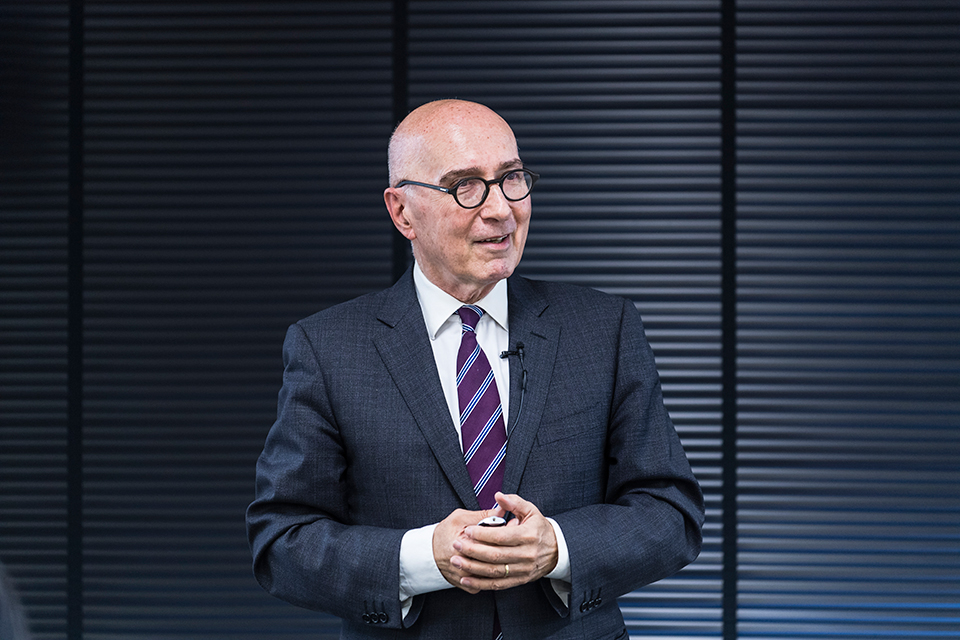 Dr. Richard Straub,
Dr. Richard Straub,
Founder and president of the Peter Drucker Society Europe
Dr. Straub noted that Drucker's popularity and relevance for Japan's business culture and economic development endures."
"Drucker has had the largest readership in Japan, and his books must be one of the most read in Japan (in the business management category)," he said. Drucker's books enjoy popularity among Japan's younger generations, as well, while US and European readers of Drucker are mostly limited to baby boomers. Some Generation Xers also read him in the West, while few from Generation Y recognize his name.
People First
Drucker's contemporaries included Freud, Wittgenstein and Schumpeter, the latter a close friend, and these intellectuals helped to nurture Drucker's thoughts and build his theories in the rich intellectual atmosphere of the times.
Straub regards Drucker as "not a dreamer, but a true realist." Drucker once remarked to one of his best friends, Jim Collins: "I'm not predicting the future or what's coming." But Drucker was trying to see what was already there; the things maybe most people don't see.
Straub emphasized that "a company cannot survive if it does not deliver results." Hence, results must be the focus of corporate efforts. But he qualified this statement by bringing in the human element. "No company can deliver results without focusing on human beings," said Straub, adding that Drucker's wife often said that her husband was a person who cared deeply about others.
Drucker also regarded corporate and individual responsibility to be of prime importance. Individuals should conduct themselves properly, not only in business but also in life, as he once wrote in the Harvard Business Review.
Management Layers
Describing Drucker's reasoning, Straub discussed three layers of management: the what, the how and the why.
The what is knowledge, concepts and theories of management, such as shared values and agility.
How relates to skills and methods and tools, such as business models and designs of new business plans and practices.
And why is wisdom; the human context, which concerns purpose, values and ethics of business and helps to refocus the organization on people and community.
"The most important layer of management is the why," explained Straub. "It's the 'why' that raises deeper questions: How are we relating to society? What value can we provide beyond being profitable? What are we contributing to our community? What is our ethical behavior?"
Straub emphasized that Drucker was very clear on the point that management does not just have a part to play in business, but a role that must extend to society as a whole.
Innovation and the Entrepreneurial society
Prior to Drucker, Schumpeter was one of the earliest proponents of innovation in business. In 1934, he wrote a book called Theory of Economic Development, in which he dissected innovation, asserting that the real hero of capitalism is not the capitalist himself but the entrepreneur who brings innovation to society and creates wealth.
In fact, for the last 250 years, entrepreneurs have contributed to society by increasing wealth in societies through achieving business results. "Prosperity went up like a hockey stick in many areas, including nutrition, health, life expectancy, security, education, mobility and others," Straub noted.
Drucker internalized Schumpeter's philosophy, further developing it and crystallizing it in his book, Innovation and Entrepreneurship. "He was the first one writing a book in a systematic way on the question of innovation and entrepreneurship," said Straub, adding, "This book is still readable, providing us with a lot of things that can be applied today."
Diversity versus Conformity
Drucker was impressed with the vision of Japan's Edo era, noting the rich diversity in the paintings of the time. "In the art of Edo period, there was an unbelievable amount of diversity, which is a source of innovation," said Straub.
Every person needs to discover their own path to the entrepreneurial society, be it through the tension inherent in diversity versus conformity in decision-making, or between choosing individualism as opposed to following socially accepted modes of behavior, Straub explained.
"You should find a way. You should find an entrepreneurial society … different from those of the US, Germany or Australia – an entrepreneurial society that is genuinely Japanese; well suited to Japanese culture and spirituality."
Toward the Innovation Society
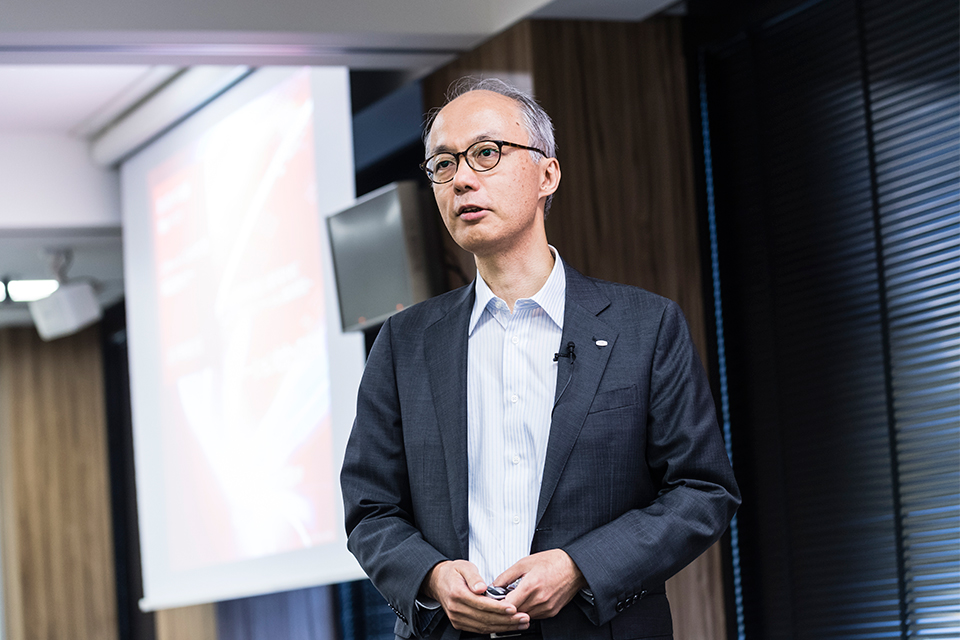 Yoshikuni Takashige
Yoshikuni Takashige
VP, Marketing Strategy and Vision, Fujitsu Ltd.
Following Straub's keynote, Mr. Takashige spoke about innovation in Japan, citing examples of initiatives that Fujitsu is driving.
Drucker praised Japanese social innovation during the early Meiji Period, said Takashige. While Japan rushed to learn Western ways such as education and banking systems, Japanese people completely internalized them. Drucker also admired Japan's global guerrilla marketing approach, calling it the "judo strategy". For example, Sony's transistor radios and Seiko's quartz watches borrowed core technologies from the West and sneaked them into already established markets.
Fujitsu also learned communications technologies from Siemens to develop crossbar-type switching equipment, leading the company to manufacture Japanese-made computers, by using relay components for totally new ways.
Paradigm Shift to Digital
After decades of growth, Japan's economic bubble burst in early 1990's and the lost decades began.
While the Japanese economy stumbled, the global business landscape drastically changed. Some of the world's most valuable companies saw themselves outpaced by digital technology platformers, such as Apple, Microsoft, Google, Amazon and Facebook. Now, no Japanese company ranks in the top 10.
"We are experiencing a paradigm shift," said Takashige.
Today, digital technologies – including artificial intelligence and IoT, or Internet of Things, – are the game changers, integrating themselves ubiquitously into everyday life, business and society. The move to digital is reshaping the industry structure. As digital technology lowers transaction costs, vertical integration no longer has much meaning. In the industrial era, vertically integrated companies supply standardized goods and services in a massive scale. But in the digital era, companies and consumers connect each other even across the borders of existing industries, shaping ecosystems for co-creating new value. We call them Digital Arenas.
To illustrate this dynamic change, Takashige talked about autonomous vehicles as a typical example. In the digital era, cars are made of digitalized hardware, software and cloud service components. We are seeing the emergence of vast ecosystems encompassing car manufactures, component suppliers, digital service providers and others. "Instead of supplying cars, they are co-creating a value of Mobility in a new Digital Arena," Takashige said.
How can companies continuously innovate?
"However, it is not easy for an existing company to deliver innovation." Takashige added. To revitalize corporate entrepreneurship, he emphasized that companies should set out their future visions to decide what to do now, regain the vitality of risk taking in a managed way, take top-down approach to avoid killing innovations, and give value to community to grow ecosystems more proactively.
Every year, Fujitsu issues its "Technology and Service Vision" to illustrate a vision of future business and society, and how companies can realize innovation using technology. Takashige said, "More importantly, this also serves a roadmap for Fujitsu to transform into a more innovative company."
To facilitate innovations, Fujitsu is leveraging design thinking approach and the power of communities. He explained about the Digital Transformation Center and other facilities where customers and Fujitsu people can hold workshops for creating visions and prototypes. The company is also strongly pursuing open innovation initiatives by setting up the Open Innovation Gateway in Silicon Valley and operating the Venture Community.
Finally, Takashige talked about the coming innovation society. People are still facing serious global challenges. In alignment of the Sustainable Development Goals (SDGs) set out by the United Nations, Fujitsu is working on co-creating shared value with customers and partners by shaping Digital Arenas for Food and Agriculture, Well-being, and Sustainable Cities, for example. Takashige said, "These Digital Arenas are not stand-alone but must be interconnected to deliver greater value for people. They will develop into a new innovation society where organizations and entrepreneurs will co-create innovation to achieve the common good of society, which Peter Drucker emphasized as the most important purpose of companies. This is our vision of the Human Centric Intelligent Society."
What Is Innovation Management?
The Way to Create Innovation for Established Companies
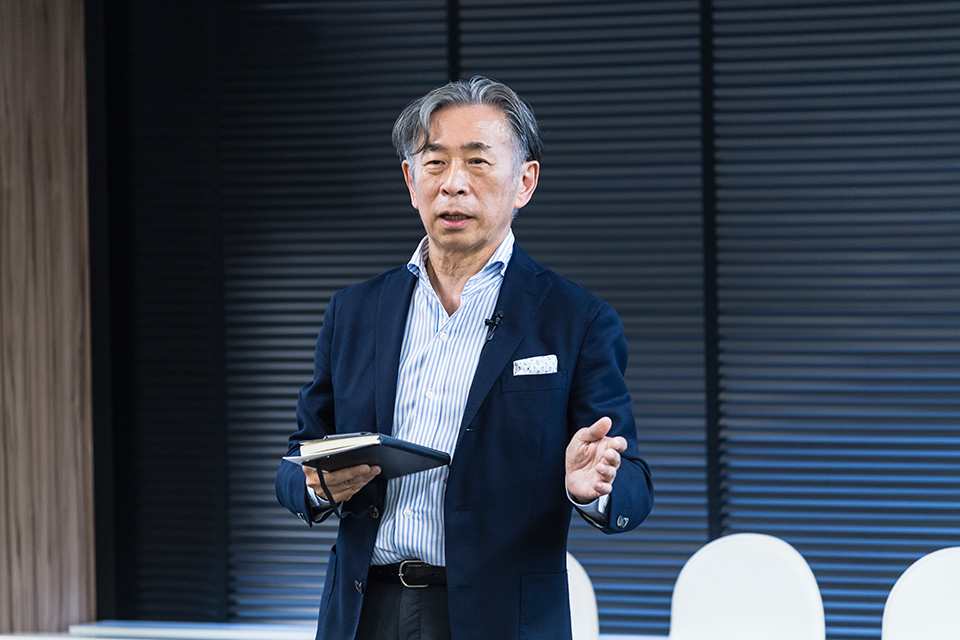 Japan Innovation Network: Professor Noboru Konno
Japan Innovation Network: Professor Noboru Konno
Besides being a professor in the Tama Graduate School of Business, Noboru Konno is a representative director of the Japan Innovation Network (JIN).![]() JIN is a nonprofit organization helping large Japanese companies accelerate innovation, focusing on team and platform development.
JIN is a nonprofit organization helping large Japanese companies accelerate innovation, focusing on team and platform development.
Large Japanese companies have a vast economic and human resources, he said. By using this potential, they are able to innovate quickly and effectively. JIN provides practical knowledge and support to make innovation happen by focusing on three areas: innovation management education; innovation management practice; and building information platforms.
JIN practices innovation management through trial and error. Most companies naturally do not welcome failure. But innovation involves failures before eventually succeeding.
The practice of innovation management includes building a community of internal innovators and sharing of best practices. As part of this effort, JIN collaborates with Kunitake Ando, Chairman and Director of Sony Life Insurance Co., to increase the number of innovation advocates within companies.
Building information platforms also involves a partnership with the United Nations Development Program, which connects over 170 UNDP offices across the globe to JIN's partner companies in Japan. Partner companies work together to deliver innovations to specific challenges. The platform provides the means for global collaboration to drive innovation.
Drucker felt entrepreneurs contribute to the common good in society by achieving positive business results. As such, JIN's activities also aim to promote the common good, believing that the general corporate culture of Japanese companies is good fit for this, Konno said.
Panel Discussion
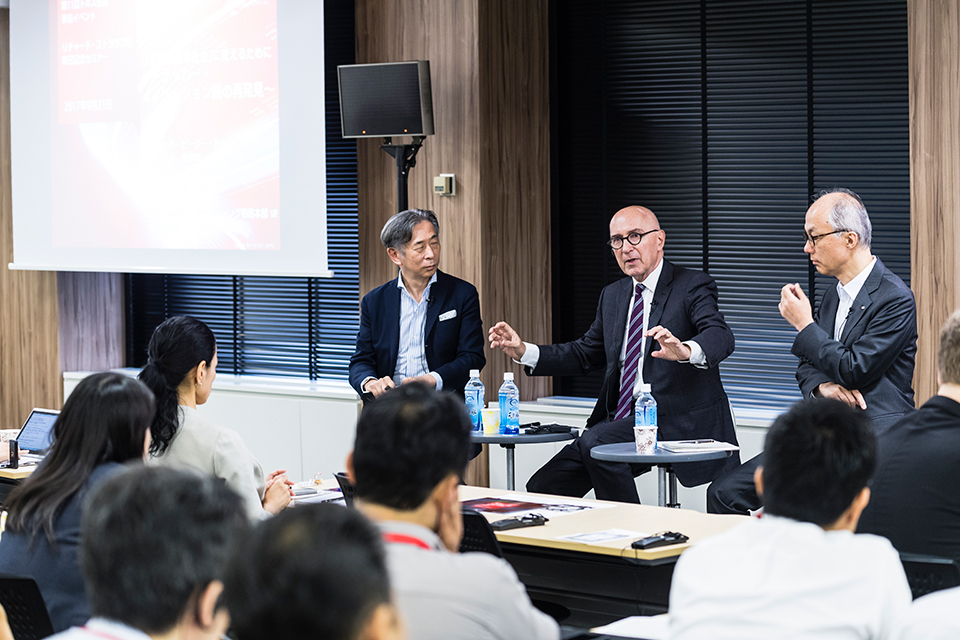
Konno led a panel discussion on innovation and how it advances the entrepreneurial society. Specifically, he posed three questions related to the changing business landscape:
- Large companies dominate domestic industries in Japan. Can they survive in the entrepreneurial society?
- Traditionally, business competition has focused on technology. But Drucker predicted a society in which businesses competed based on values of art and human beings. Is such a society on its way?
- What can we do to realize such a human-centric society?

Straub
As I see it, large-sized companies have become machines, efficient machines. I call it the "Cult of Efficiency." Their focus is on efficiency, even for innovation and start-ups.
This tendency is most apparent in the US. They are trying to make profits on stock markets over the short term. The profits then go back to investors.
But is it healthy from a long-term perspective? I worked at IBM for many years, seeing development of mainframe and PC businesses. During development, the company's focus was mainly on technology, not on human beings.
Companies should not be technology-centric, but human-centric, which Fujitsu has chosen for its approach. But this is not easy, as companies should drive their business in a human-centric way while understanding technologies. In order to be human-centric, we need to have a deep understanding of history and culture, as well as an anthropological perspective. Understanding this, we can understand how technologies can serve people.
I wonder if AI can really do a job better than a human being. We all know that humans are not made of data.
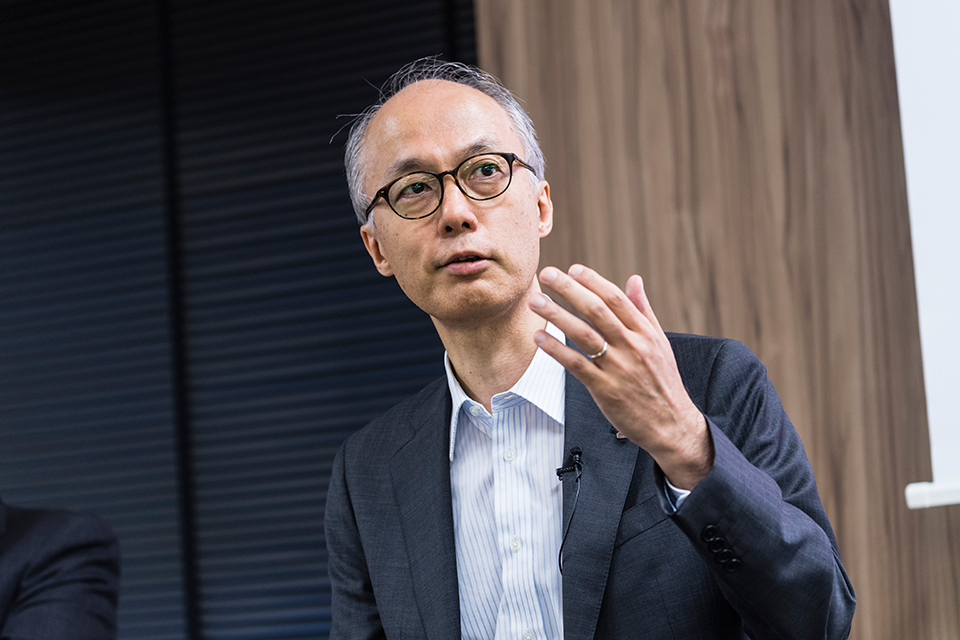
Takashige
I'm glad that Fujitsu and IBM finally share the same opinion. At Fujitsu, we work for our human-centric vision, putting people at the center of everything. These days, companies need to run businesses that consider people more.
Companies still tend to consider employees a burden, which appears as cost of human resources in P&L, missing their potential as value creators. In other words, companies are still not able to assess the potential value of an individual.
To regain the vitality of risk taking, we must allow younger employees to experience a variety of challenging roles to expand experience and develop skills. This was what Japanese companies rightly did decades ago, but not today.
It's also hard for existing business divisions to innovate while maintaining their operations. For example, Fujitsu is developing information systems for corporate customers. Our systems engineers have to meet customers' requirements accurately and develop systems without any failures and delays in a reliable way. This is working well and not at all bad. But to innovate, we need to think about the challenges and opportunities which even customers do not exactly know. We need a new organization and team for this purpose. This year, Fujitsu set up a new organization for digital innovation, growing people with new skills of business produce, design and digital engineering.
Can large companies survive in the entrepreneurial society? Big companies will experience drastic changes in the next 10 years. Their vertical value chains will be disintegrated. The chance is to embrace digital ecosystems with partners and transform into an innovative company.
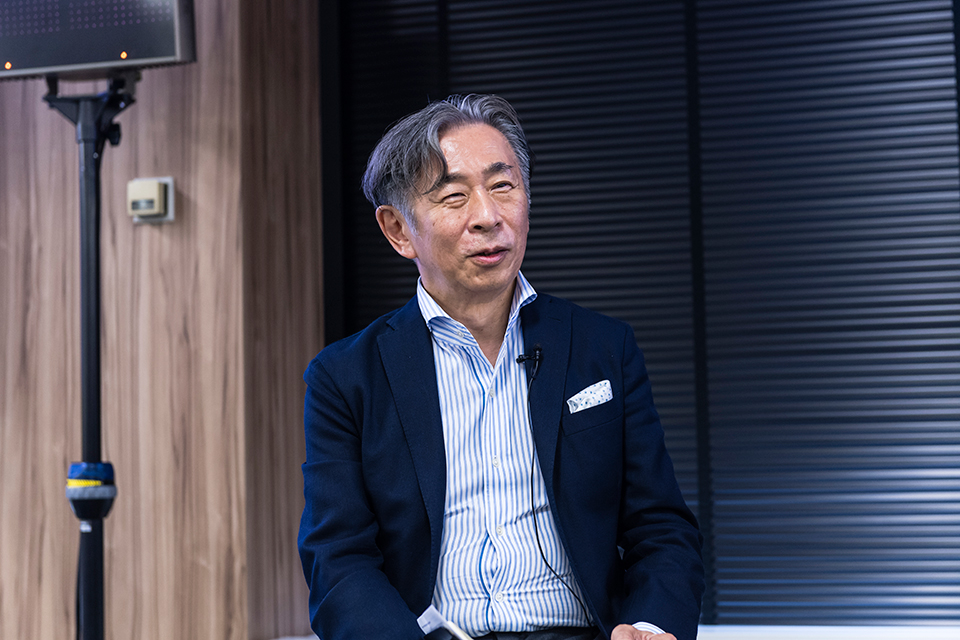
Konno
Dr. Straub mentioned the Cult of Efficiency. As he pointed out, the pressures of capital markets are so strong that our discussion of the human-centric entrepreneurial society might be criticized as naïve. It might even be called a dream or illusion.
But if we consider that Japanese management is not as concerned about investors and stock prices as their US counterparts, is this mentality an advantage for Japanese companies to innovate? If so, let me ask: Are Japanese companies more likely to innovate?
Straub
Recently, I met the CEO of Vinci Group, a French construction group. They build social infrastructure, including dams and subways. He said his group's corporate value is one tenth of Facebook on the stock market. Then I thought the social value of the group may be higher than Facebook in the sense that they support people's life through their business more fundamentally than Facebook.
I think this is a big issue; big enough for us to discuss at next year's Drucker Forum focusing on human capital. The most valuable asset for a company is the human being. So it is wrong to consider human resources as cost.
Takashige
When I was studying for my MBA at Cornell University in the US, a professor told the students during the first lecture that the purpose of a company is to maximize the value for shareholders which own the company. I was kind of shocked hearing it, though I accepted it at that time. Later, I had an opportunity to work with European companies and learned that they care more for their employees than US companies.
Today, I see corporate management understanding more and more that not only shareholders – but also employees, customers and their communities – are stakeholders. Also, I think Generation Y, people born after the 80s, are more sensitive to social values. They tend to reject the brands they feel are not contributing to society.
Professor Konno then invited questions from the audience.
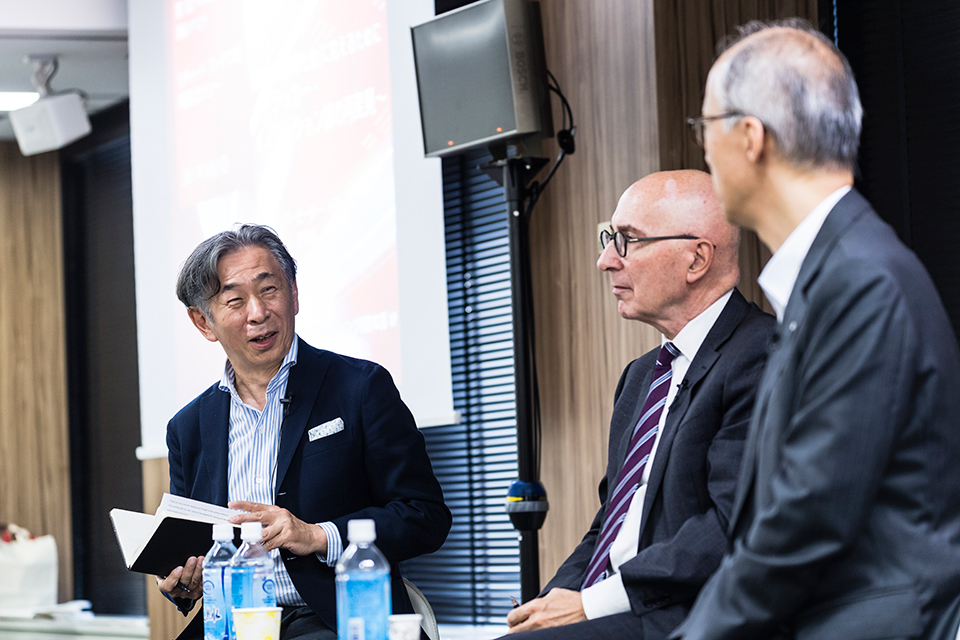
Participant A (IT professional)
It was interesting to hear that a large company created a new division devoted to innovation. How did it choose team members and guide them?
Takashige
Large IT companies in Japan have often passed jobs on to system engineers at group companies or third parties. It is efficient, but might have led to missing opportunities for developing the edges of their human resources.
Fujitsu has merged group system engineering companies, and also set up a new organization to accelerate digital innovation for our customers. We are re-positioning people internally, educating them and fostering new digital innovators for this purpose.
In the West, companies use M&As to acquire human assets. We do not deny this at all. But at least at Fujitsu, we also try to maximize our existing talent pool.
Straub
I'd like to add one more thing, which is that engagement rates are currently very bad in large companies. Employees have potential for new things, but they are "demotivated." This stops employees from growing to be innovators and causes innovation loss. A company changes a lot if they succeed in increasing their engagement rate to 70% or higher.
Konno
The lack of motivated employees may be a big issue for management. A report shows that less than 30% of employees have clear goals. This is a significant impediment to business. Also, 10% of motivated employees may be defeated by the other 90%, who have different attitudes about work.
Participant B (Professor)
Does it make a difference if a society introduces value-based pricing, which work to determine prices based on user experience or values that a product or service delivers?
Straub
I agree on a value-based pricing mechanism. Internet companies are already using pricing strategies that are different from traditional ones. They provide convenience and experience in exchange for users' personal data. Users first did not realize what was happening, but now became aware of the risks.
Anyway, it is not easy to implement the new, value-based pricing in increasingly harsh competitive markets.
Takashige
Pricing is an issue at Fujitsu, as well. Prices for developing information systems are typically determined based on how many man-months of engineering work are required. Such pricing fails to capture what value such information systems will produce for each customer.
For value-based pricing, we have to develop a shared understanding with a customer or a buyer about the business impacts and outcomes of implementing new technology. This is not easy. But all Japanese industries have to consider this in the digital era.
Konno
This goes back to Dr. Straub's anecdote about an infrastructure builder's corporate value being one-tenth of Facebook's.
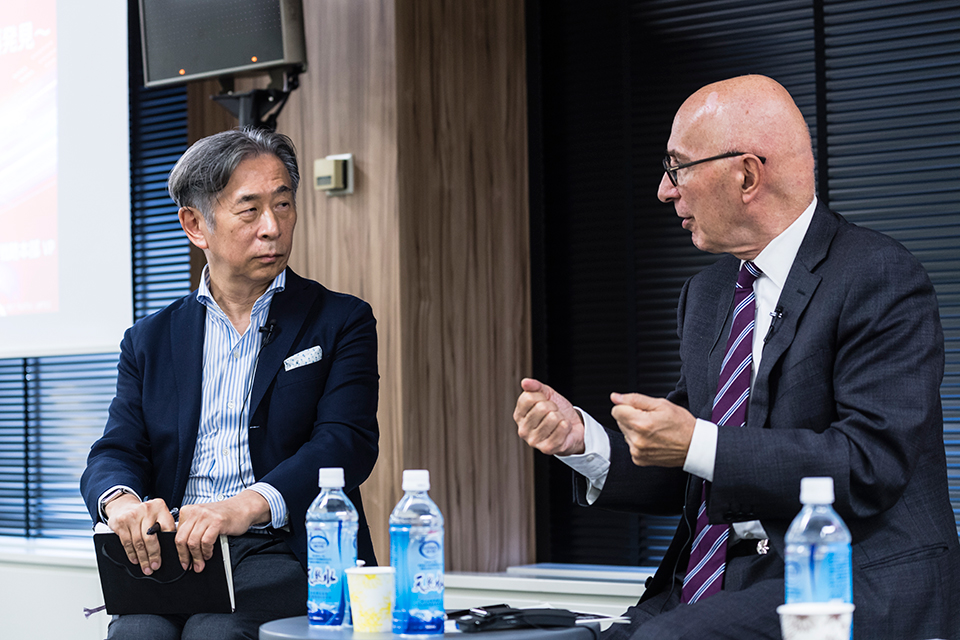
Participant C (JIN member)
When a company innovates, how should it evaluate a project – including staff – especially in terms of timing, compared with usual quarterly and annual evaluations?
Takashige
Operational projects are predictable, so we can evaluate them by normal quantitative metrics such as quarterly financial reviews. But we can't evaluate innovation this way. This makes it important for management to set clear goals and milestones. Progress of innovation projects should be checked against such goals and milestones. Personnel evaluation metrics should be also carefully aligned with such goals and milestones to capture different nature of innovation projects.
Konno
As for business evaluations, Japanese companies usually showcase what they have achieved in their annual reports, while the US companies – Tesla for example –tends to focus on what they are going to achieve in coming years. How about European companies?
Straub
European companies are evaluated by stock markets, just like US companies. It's like a disease. One clear difference I see is that there are many family-owned, midsize companies doing well on stock markets in Europe.
These companies operate like a hybrid of family business and established corporations, and the engagement rates of the companies are very high, probably because management is also comprised of owners. I think the engagement rate is a good index to evaluate a company. A higher engagement rate may indicate potential for growth, while a continuously low rate may point to bankruptcy.
Participant D (Entrepreneur)
Employees with good skills and entrepreneurship tend to spin-off from companies. How can large companies retain this kind of talent?
Straub
To the entrepreneur, spin-off may mean a big success but also a big risk. He or she may have been able to use organizations and resources to support ideas while staying in a company. Leave or stay, the choice is yours.
Large companies are often bureaucratic due to the complexities of business and the necessity to choose safe decisions to avoid failure. Naturally, it becomes centralized. I think they need to decentralize to be structurally flat in order to keep talented entrepreneurs from leaving.
Takashige
When I worked as Strategic Alliance Director, I happened to see an interesting practice of ‘spin-in' which our Alliance Partner, Cisco Systems, used. This allows employees with an innovative idea to temporarily leave the company to pursue their own business, then return if their new idea shows good potential for success. This spin-in practice can be an option to keep talented entrepreneurs within a company.

Participant E (IT professional)
How does diversity of people, thoughts and backgrounds work to nurture creativity and innovation in a company?
Takashige
A report shows that diversity is important in creating innovation. From my experience, I see many talented young women are eager to take more responsibilities, and feel we should give more opportunities and let them take on bigger challenges.
Straub
When I was at IBM, we were often talking about T-shape skills. The vertical part of a T means a specialized area of skills, while the horizontal part (means) a wider area of knowledge other than one's (own skills). T means the connection of two areas of skills and knowledge.
An editor at the Financial Times, Gillian Tett, wrote in her book published last year that a company requires knowledge of anthropology to cope with the complexity and challenges of innovation. I think we also need diversity of this sort.
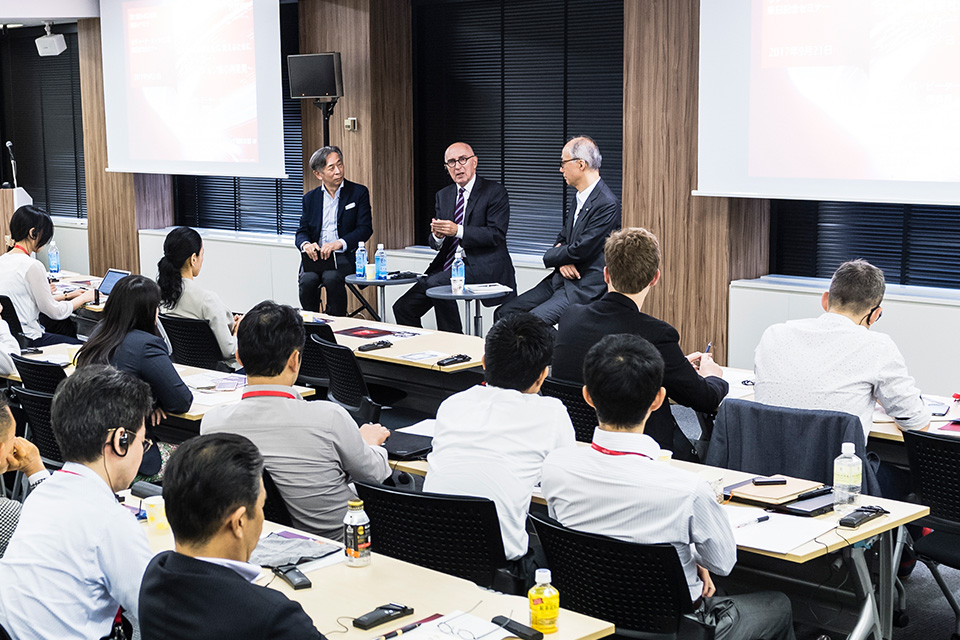
Participant F (Construction professional)
In Japan today, many companies work together in efforts such as recovering from the earthquake. They are collaborating and at the same time competing in projects. How can we productively collaborate and compete in joint projects?
Straub
I'm not familiar with the Japanese construction industry, but I may say that they need to build a consensus with all the stakeholders through frank discussion and drive the project together. In France, people are not so generous but critical about everything. They first reject anything when someone tries to change something. They (companies) cannot succeed without patiently talking to stakeholders and finding advantages for everyone.
Takashige
We often call it 'drawing a big picture.' It can be productive if management in the construction industry and others meet and discuss to define a clear future vision. Common goals and specific initiatives would be logically drawn from the vision.
Closing the discussion, two speakers shared their thoughts about the entrepreneurial society.
Takashige
The entrepreneurial society requires companies to serve their communities and help create healthy ecosystems. If Japanese companies are determined to serve their communities by "giving" talents and resources proactively, they should help in building a unique entrepreneurial society different from Silicon Valley. I trust that day is coming.
Straub
The entrepreneurial society is not limited to start-ups. I believe it means a mindset. We have been living in an employee-based society. It is completely different from the entrepreneurial society.
The world has changed drastically. Advanced technologies have created new relationships between the individual and company. In these times of change, it's important to redefine what relationships we have with society, culture and the economy. A new perspective is required. We are seeing an increasing number of freelance people or contractors working within companies.
It is the question of social contract. The entrepreneurial society is in need of a new social contract."
Professor Konno ended the discussion by returning to the theme of the event.
"The possibility is that we may have already been living in the entrepreneurial society without being aware," Professor Konno said. He felt that Japan doesn't have to worry too much about embracing either profit-driven or common-good-driven approaches, or about the US or European style of doing business.
"Let us embrace what our business instinct leads us to, because it has been our history and proven advantage that Japan takes in whatever is useful from the outside and produces value in our own way."




